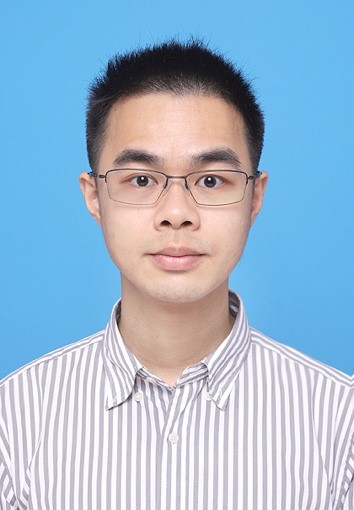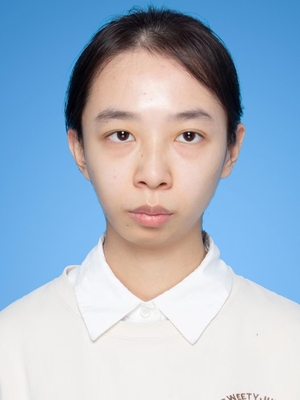贺文宇课题组介绍
|
贺文宇,助理教授、研究员 通讯地址:上海市浦东新区华夏中路393号物质学院4号楼101 教育经历: 2009.9-2013.7 北京师范大学,学士 2013.8-2015.7 香港科技大学,硕士 2015.8-2018.8 香港科技大学,博士 工作经历: 2018.9-2020.11 香港科技大学,博士后研究员 2020.11-2022.01 麻省理工学院,博士后研究员 2022.4-至今 上海科技大学,助理教授、研究员
Wen-Yu He, Assistant Professor, Principal Investigator Address: Room 101, Building 4, School of Physical Science and Technology, 393 Middle Huaxia Road, Pudong, Shanghai, 201210 Email: hewy@shanghaitech.edu.cn Short Biography I finished my undergraduate studies at Beijing Normal University in 2013. After that, I went to the Hong Kong University of Science and Technology and started my postgraduate study. At beginning, I worked on photonics in C. T. Chan’s group and obtained my Mphil degree in 2015. Then I got interested in condensed matter theory and transferred to K. T. Law’s group to pursue my Ph. D degree. After my Ph. D graduation in 2018, I stayed in Law’s group for 2 years as a postdoctoral fellow. In 2020, I moved to the Materials Research Laboratory at MIT and worked with P. A. Lee as a postdoctoral associate. In 2022, I came back and joined the SPST at ShanghaiTech. |
我的研究领域主要集中在凝聚态物理。自上世纪八十年代量子霍尔效应和高温超导现象发现以来,物质中的拓扑态、电子的强关联效应和非常规超导态一直是凝聚态领域中经久不衰的研究热点。近年来,随着单层石墨烯的问世,各式各样的二维量子材料相继涌现,为研究物质的拓扑态、电子的强关联效应和超导态提供了良好的二维材料平台。结合近年来涌现的各式新型二维量子材料,特别是二维过渡金属硫化物、双层有转角石墨烯和二维莫尔超晶格材料等,本课题组将主要用量子场论、平均场理论和群论等方法对材料中的关联绝缘态、拓扑态、超导特性和电磁性质等进行研究。课题组的研究内容注重预言材料中的新物性和新物相,以及解释实验中观测到的新现象。课题组同时对基于新型量子材料的电子实用器件设计具有强烈兴趣。在最近5年,我的研究论文重点涉及了以下内容:
1. 二维莫尔超晶格材料的量子反常霍尔效应;
2. 超导和金属的磁电响应;
3. 1T-TaS2/1T-TaSe2中的量子自旋液体态;
4. 二维过渡金属硫化物的超导态;
5. 量子振荡;
6. 近藤效应;
……
除上述研究内容以外,课题组对自主探索新的研究方向秉持开放的态度。
My research interest mainly focuses on the field of condensed matter. In the field of condensed matter, since the discovery of the fractional quantum Hall effect and the high Tc superconductivity in 1980s, the study has been focused on the topological states, electronic strong correlation effects, and unconventional superconductivity phenomenon for a long time. In recent years, the advent of monolayer graphene has boosted the emergence of various types of new two-dimensional quantum materials, which can serve as good platforms for the study of topological states, strong correlation effects and superconductivity. Considering the emerging various types of two-dimensional quantum materials, especially the two-dimensional transition metal dichalcogenides, twisted bilayer graphene and two-dimensional Moiré superlattice materials, our group will apply quantum field theory, mean field theory and group theory to carry out a series of study on the correlated insulating states, topological states, superconducting states, and electromagnetic properties that are associated with those new quantum materials. The research carried out in our group will focus on the predictions of new physical states and properties that can emerge in the quantum materials, and we will also work on explanations to new experimental observations. Meanwhile, our group have strong interest in developing electronic device with practical applications that are based on the new quantum materials. In the past 5 years, my research works mainly focused on the following topics:
1. Quantum anomalous Hall effect in two-dimensional Moiré superlattice materials;
2. Magnetoelectric effect in metals and superconductors;
3. Quantum spin liquid phase in 1T-TaS2 and 1T-TaSe2;
4. Superconducting states in two-dimensional transition metal dichalcogenides;
5. Quantum oscillations;
6. The Kondo effect;
……
Apart from the research directions mentioned above, I hold open mind to encourage group members to explore other new research directions by themselves.
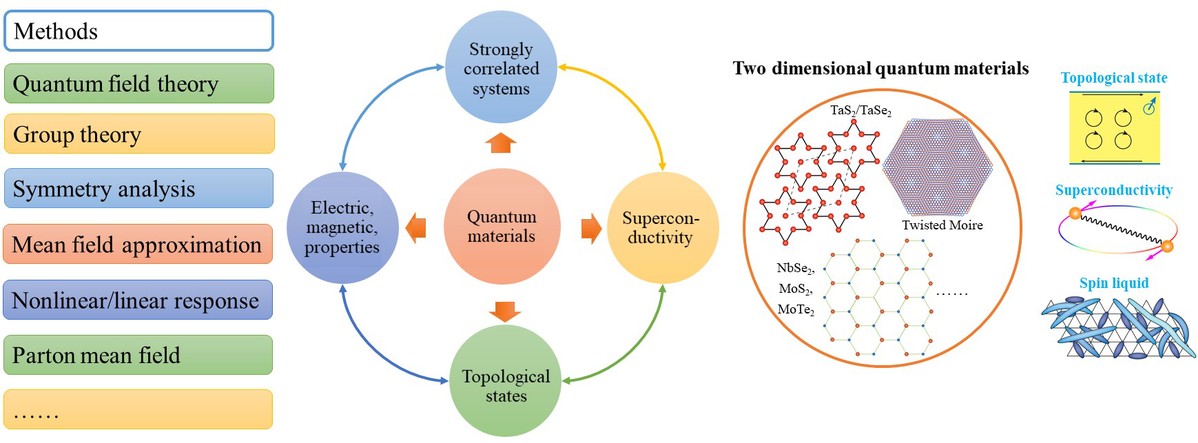
课题组目前刚成立,欢迎有志于从事凝聚态理论研究的学生学者加盟。本课题组每年预期招1-2名硕博连读研究生,1-2名博士后研究员。
课题组将为优秀的博士后研究员提供有竞争力的薪酬待遇 (年薪30万),并可协助申请学校提供的廉价校内博士后公寓。博士后研究员在站期间可根据其意愿和研究表现,申请转为助理研究员。助理研究员在学校是具有事业编制的正式职位,将依据学校规定进入研究员序列,按照助理研究员→副研究员→研究员路线晋升,并获得可持续发展的薪酬待遇。在科研经费方面,课题组将为每一位博士后研究员和助理研究员提供优渥的科研经费支持。优秀的博士后研究员和助理研究员可依托课题组申请上海市“超级博士后”激励计划、博士后创新人才支持计划和上海市青年科技英才扬帆计划以及其它各类面向青年科技人才的资助计划。请有意申请者发送学术简历至hewy@shanghaitech.edu.cn与本人联系。
同时,课题组热烈欢迎对科研感兴趣的本科生加入。
I joined ShanghaiTech very recently and the research group is recruiting students and researchers who are interested in the field of condensed matter. Our group plans to recruit 1-2 students and 1-2 postdoctoral fellows per year.
For excellent postdoctoral fellows, our group can offer highly competative salary (around 300K RMB per year), and help the postdoctoral fellows to apply the in-campus housing at a discount. For the postodoctoral fellow with strong academic performance, he (or she) can apply to transfer to be an assitant researcher if he (or she) wishes. The assistant researcher, different from the postdoctoral fellow, is a long term job provided by the university. According to the current policy of the university, the assistant researcher can get promoted to be an associated researcher and finally become a permanent researcher. During the promotion process, the researcher's salary and benefits get increasd accordingly. In the aspect of the research funding, our group will provide every postdoctoral fellow and assitant researcher with adequate funding support. The group will encourage and recommend the postdoctoral fellow and assistant researcher to apply Shanghai Super Postdoctoral Fellow, Postdoctoral Innovative Talents Support Program, Shanghai Sailing Program and other support plans for young researchers. Applicants who are interested in joining our group can send the CV to hewy@shanghaitech.edu.cn by email.
Besides the graduate students and postdoctoral fellows, undergraduate students who are interested in condensed matter theory are welcome to start research projects in our group.
Research works (*equal contribution, †co-corresponding author)
Publications after joining ShanghaiTech
1. Tunable Mirro-Symmetric Type-III Ising Superconductivity in Atomically-Thin Natural Van der Waals Heterostructures, X. Sun, Z. Deng, Y. Yang, S. Yu, Y. Huang, Y. Lu, Q. Tao, D.-W. Shen†, W.-Y. He†, C. Xi, L. Pi, K. Watanabe, T. Taniguchi, Z.-A. Xu†, and Y. Zheng†, Adv. Mater. 37, 2411655 (2025).
2. Topological superconductivity in monolayer Td-MoTe2, X.-Z. Li, Z.-B. Qi, Q. Wu, and W.-Y. He†, Commun. Phys. 7, 396 (2024).
3. Nematic Ising Superconductivity with hidden magnetism in few-layer 6R-TaS2, S.-B. Liu, C. Tian, Y. Fang, H. Rong, L. Cao, X. Wei, H. Cui, M. Chen, D. Chen, Y. Song, J. Cui, J. Li, S. Guan, S. Jia, C. Chen, W. He, F. Huang, Y. Jiang, J. Mao, X. C. Xie, K. T. Law, J.-H. Chen, Nat. Commun. 15, 7569 (2024).
4. Selective and quasi-continuous switching of ferroelectric Chern insulator devices for neuromorphic computing, M. Chen, Y. Xie, B. Cheng, Z. Yang, X.-Z. Li, F. Chen, Q. Li, J. Xie, K. Watanabe, T. Taniguchi, W.-Y. He, M. Wu, S.-J. Liang and F. Miao, Nat. Nanotechnol. 19, 962 (2024).
5. Quantum spin liquid signatures in monolayer 1T-NbSe2, Q. Zhang*, W.-Y. He*, Y. Zhang*, Y. Chen*, L. Jia, Y. Hou, H. Ji, H. Yang, T. Zhang, L. Liu, H.-J. Gao, T. A. Jung and Y. Wang, Nat. Commun. 15, 2336 (2024).
6. Electronic density of states of a U(1) quantum spin liquid with spinon Fermi surface. I. orbital mangetic field effects, W.-Y. He† and Patrick A. Lee†, Phys. Rev. B 107, 195155 (2023). Editor's Suggestion.
7. Electronic density of states of a U(1) quantum spin liquid with spinon Fermi surface. II. Zeeman mangetic field effects, W.-Y. He† and Patrick A. Lee†, Phys. Rev. B 107, 195156 (2023). Editor's Suggestion.
8. Evidence for a spinon Kondo effect in cobalt atoms on single-layer 1T-TaSe2, Y. Chen*, W.-Y. He*, W. Ruan*, J. hwang, S. Tang, R. L. Lee, M. Wu, T. Zhu, C. Zhang, H. Ryu, F. Wang, S. G. Louie, Z.-X. Shen, S.-K. Mo, P. A. Lee and M. F. Crommie, Nat. Phys. 18, 1335 (2022).
9. Magnetic impurity as a local probe of the U(1) quantum spin liquid with spinon Fermi surface, W.-Y. He† and Patrick A. Lee†, Phys. Rev. B 105, 195156 (2022).
Selected Publications before joining ShanghaiTech
10. Superconducting orbital magnetoelectric effect and its evolution across the superconductor-normal metal phase transition, W.-Y. He†, and K. T. Law†, Phys. Rev. Research 3, L032012 (2021).
11. Giant orbital magneto-electric effect and current-driven magnetization switching in twisted bilayer grpahene, W.-Y. He†, David Goldhaber-Gordon, K. T. Law†, Nat. Commun. 11, 1650 (2020).
12. Magnetoelectric effects in gyrotropic superconductors, W.-Y. He, and K. T. Law, Phys. Rev. Research 2, 012073 (R) (2020).
13. Transport evidence of asymmetric spin-orbit coupling in few-layer superconducting 1Td-MoTe2, J. Cui*, P. Li*, J. Zhou*, W.-Y. He*, X. Huang, J. Yi, J. Fan, Z. Ji, X. Jing, F. Qu, Z. G. Cheng, C. Yang, L. Lu, K. Suenaga, J. Liu, K. T. Law, J. Lin, Z. Liu, G. Liu, Nat. Commun. 10, 2044 (2019).
14. Spinon Fermi Surface in a Cluster Mott Insulator Model on a Triangular Lattice and Possible Application to 1T-TaS2, W.-Y. He, X. Y. Xu, G. Chen, K. T. Law, and P. A. Lee, Phys. Rev. Lett. 121, 046401 (2018).
15. Nodal topological superconductivity in monolayer NbSe2, W.-Y. He, B. T. Zhou, J. J. He, N. F. Q. Yuan, T. Zhang, and K. T. Law, Communications Physics 1, 40 (2018). Editor’s pick.
16. An unusual continuous paramagnetic-limited superconducting phase transition in 2D NbSe2, E. Sohn, X. Xi, W.-Y. He, S. Jiang, Z. Wang, K. Kang, J.-H. Park, H. Berger, L. Forro, K. T. Law, J. Shan, and K. F. Mak, Nat. Mater. 17, 504 (2018).
17. Synthetic gauge flux and Weyl points in acoustic systems, M. Xiao, W.-J. Chen, W.-Y. He, and C. T. Chan, Nat. Phys. 11, 920 (2015).
18. Chiral Tunneling in a Twisted Graphene Bilayer, W.-Y. He, Z.-D. Chu, and L. He, Phys. Rev. Lett. 111, 066803 (2013).
19. Strain and curvature induced evolution of electronic band structures in twisted graphene bilayer, W. Yan*, W.-Y. He*, Z.-D. Chu*, M. Liu, L. Meng, R.-F. Dou, Y. Zhang, Z. Liu, J.-C. Nie, and L. He, Nat. Commun. 4, 2159 (2013).
Other Publications
20. Topological superconductivity in multifold fermion meetals, Z. S. Gao, X.-J. Gao, W.-Y. He, X. Y. Xu, T. K. Ng, and K. T. Law, Quantum Frontiers 1, 3 (2022).
21. Quantum oscillation of thermally activated conductivity in a monolayer WTe2-like excitonic insulator, W.-Y. He and Patrick A. Lee, Phys. Rev. B 104, L041110 (2021).
22. Kramers Weyl semimetals as quantum solenoids and their applications in spin-orbit torque devices, W.-Y. He†, Xiao Yan Xu, and K. T. Law†, Commun. Phys. 4, 66 (2021).
23. Berry curvature-induced emerging magnetic response in two-dimensional materials, Y.-T. Liu, W.-Y. He, J.-W. Liu, and Q. M. Shao, Acta Physica Sinica 70 (12), 127303 (2021).
24. From nodal ring topological superfluids to spiral Majorana modes in cold atomic systems, W.-Y. He, D.-H. Xu, B. T. Zhou, Q. Zhou, and K. T. Law, Phys. Rev. A 97, 043618 (2018).
25. Superconductivity-induced ferromagnetism and Weyl superconductivity in Nb-doped Bi2Se3, N. F. Q. Yuan, W.-Y. He, and K. T. Law, Phys. Rev. B 95, 201109 (R) (2017).
26. Nematic topological superconducting phase in Nb-doped Bi2Se3, J. Shen, W.-Y. He, N. F. Q. Yuan, Z. Huang, C. Cho, S. H. Lee, Y. S. Hor, K. T. Law, and R. Lortz, npj Quantum Materials 2, 59 (2017).
27. Ising Superconductivity in Transition Metal Dichalcogenides, N. F. Q. Yuan, B. T. Zhou, W.-Y. He, and K. T. Law, AAPPSBL. 26, 3, 12 (2017).
28. The realization and detection of Weyl semimetals and chiral anomaly in cold atomic systems, W.-Y. He, S. Zhang, and K. T. Law, Phys. Rev. A 94, 013606 (2016).
29. A new platform for engineering topological superconductors: superlattices on Rashba superconductors, Y. Lu*, W.-Y. He*, D.-H. Xu, N. Lin, and K. T. Law, Phys. Rev. B 94, 024507 (2016).
30. The Emergence of Dirac points in Photonic Crystals with Mirror Symmetry, W.-Y. He, and C. T. Chan, Sci. Rep. 5, 8186 (2015).
31. Creating in-plane pseudomagnetic fields in excess of 1000T by misoriented stacking in a graphene bilayer, W.-Y. He, Y. Su, M. Yang, and L. He, Phys. Rev. B 89, 125418 (2014).
32. Coexistence of van Hove singularities and superlattice Dirac points in a slightly twisted graphene bilayer, Z.-D. Chu*, W.-Y. He*, and L. He, Phys. Rev. B 87, 155419 (2013).
33. Strain-induced one-dimensional Landau level quantization in corrugated graphene, L. Meng, W.-Y. He, H. Zheng, M. Liu, H. Yan, W. Yan, Z.-D. Chu, K. Bai, R.-F. Dou, Y. Zhang, Z. Liu, J.-C. Nie, and L. He, Phys. Rev. B 87, 205405 (2013).
34. Coupled spin and pseudomagnetic field in graphene nanoribbons, W.-Y. He, and L. He, Phys. Rev. B 88, 085411 (2013).
35. Ultrathin α-Fe2O3 Nanoribbons and Their Moire Patterns, R. Xu, H. Yan, W.-Y. He, Y. Su, J. C. Nie, and L. He, J. Phys. Chem. C, 116(12), (2012).
36. Effect of exchange-type zero-bias anomaly on single-electron tunneling of Au nanoparticles, R. Xu, Y. Sun, H. Yan, J.-Y. Yang, W.-Y. He, Y. Su, L. He, J.-C. Nie, and Y. Li, Phys. Rev. B 84, 195470 (2011).
Postgraduate student
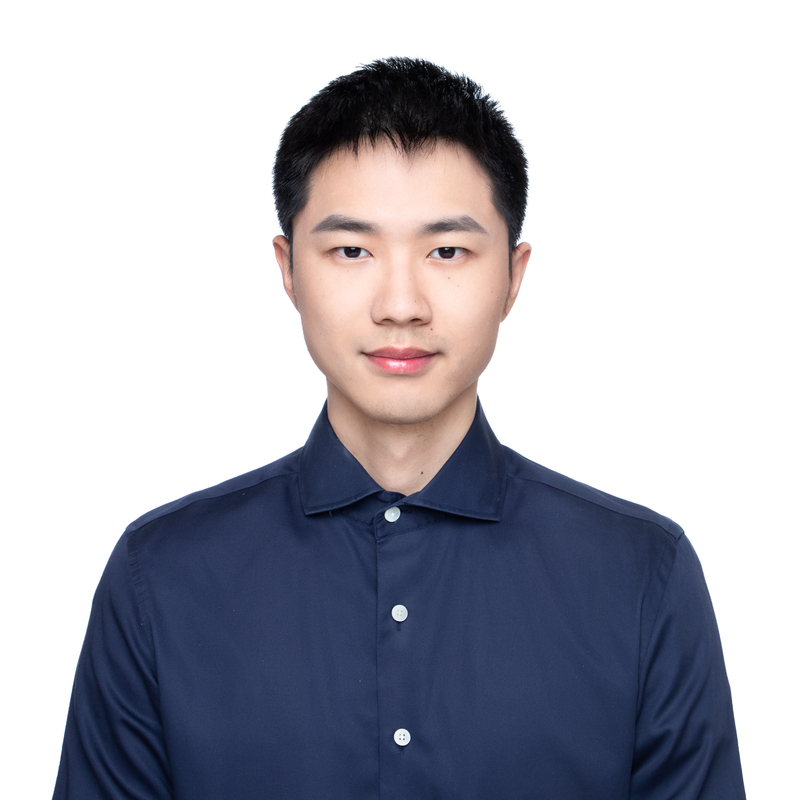
李鑫智,2022级博士生
本科毕业院校:上海科技大学
邮箱:lixzh2022@shanghaitech.edu.cn
办公室:物质学院8号楼203
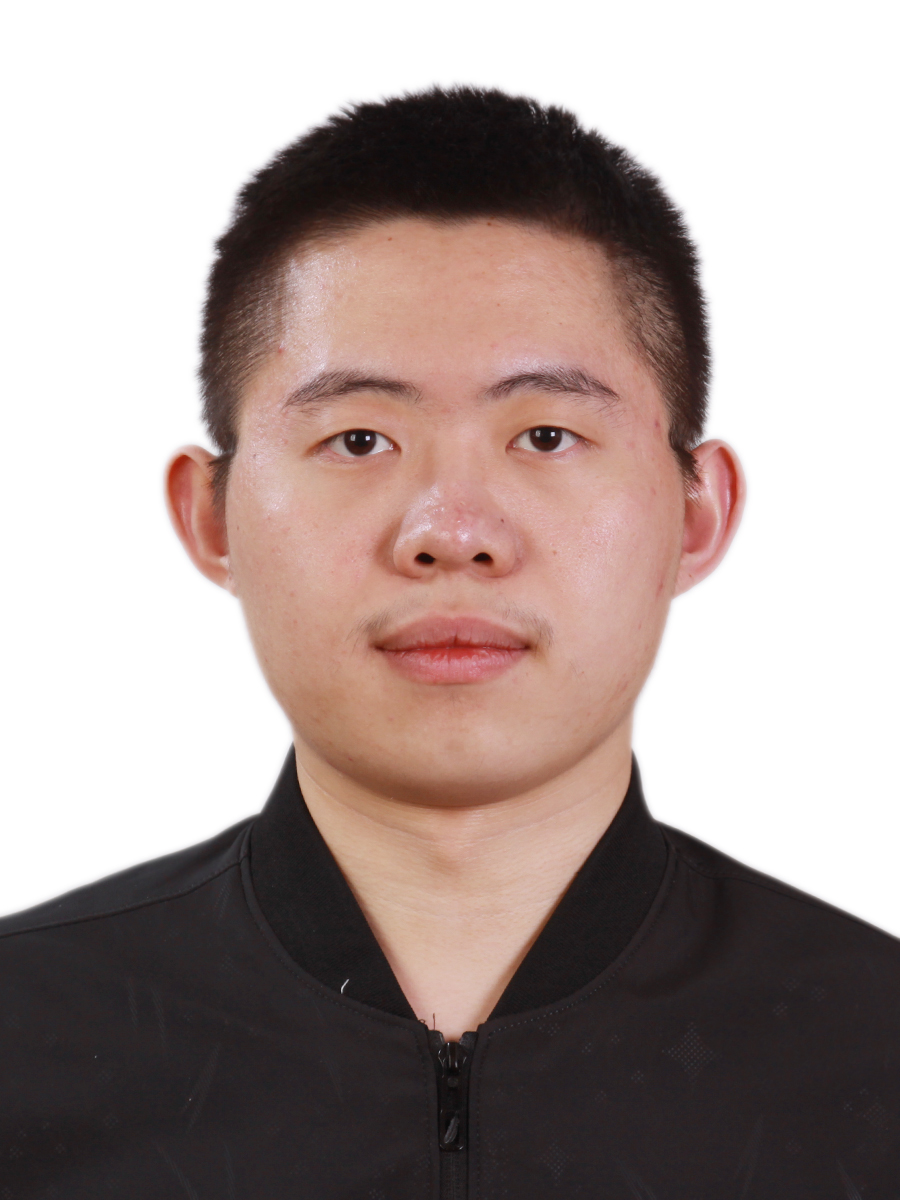
齐振博,2022级博士生
本科毕业院校:中国科学技术大学
邮箱:qizhb2022@shanghaitech.edu.cn
办公室:物质学院8号楼203
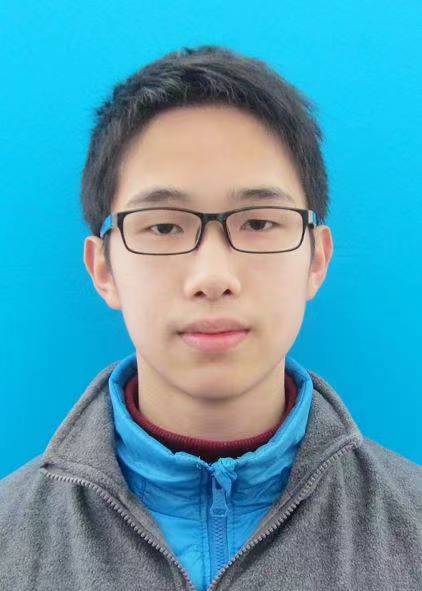
张嘉文,2023级硕士生
本科毕业院校:上海科技大学
Undergraduate student

张泽晟,2022级本科生
邮箱:zhangzsh2022@shanghaitech.edu.cn
Former members
Undergraduates
安 南 Msc. in Computer Science at McMaster University, Canada
刘佩尧 Graduate student at Institute of Physics, Chinese Academy of Science
张嘉文 Graduate student at SPST, ShanghaiTech University

2025.01.18 课题组聚餐合影
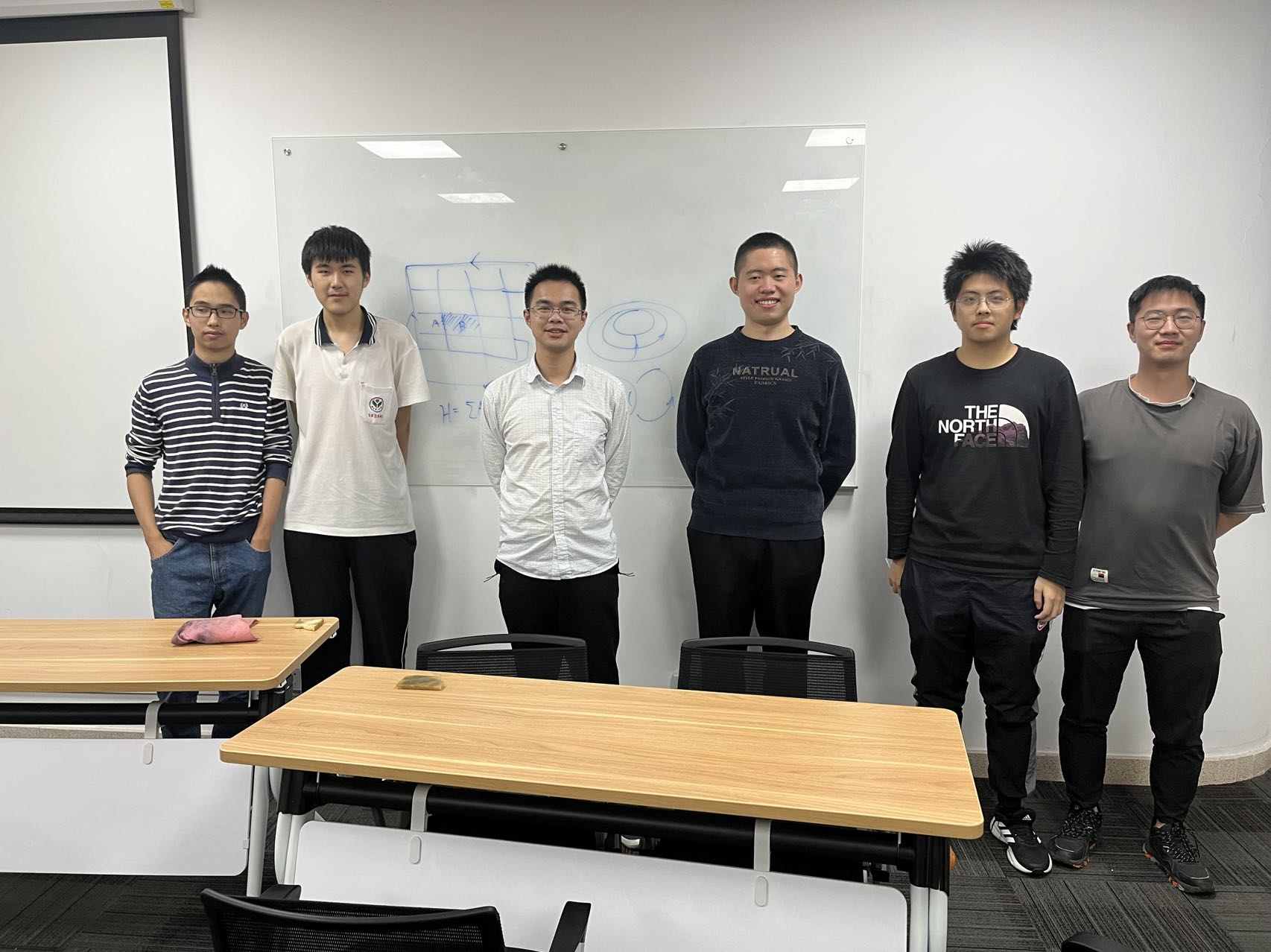
2022.10.21 课题组讨论会合影
We are recruiting. You are welcome to join us!



